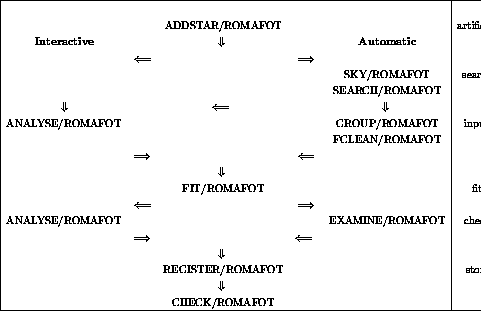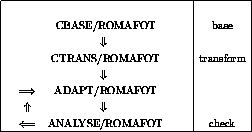The current MIDAS implementation of ROMAFOT consists of 17 commands which
are listed in Table ![]() . In order to be able to
execute these commands the context ROMAFOT should be enabled first. This
can be done using the command SET/CONTEXT ROMAFOT.
. In order to be able to
execute these commands the context ROMAFOT should be enabled first. This
can be done using the command SET/CONTEXT ROMAFOT.
ROMAFOT is as interactive as the user wishes. In fact, during a reduction session the user is often asked to choose between an interactive or an automatic procedure, including ``greytone'' extremes. Hence, the package leaves it up to the user:
As stated above, apart from a part which has to be interactive,
the user can choose between running ROMAFOT in automatic or in
interactive mode. Hence, a number of interactive ROMAFOT commands have
non--interactive ``sister'' command(s) with the same functionality.
Figure ![]() shows the flow diagram of the
ROMAFOT package. From this diagram it is clear that after determining
the PSF one can continue along two paths.
Figure
shows the flow diagram of the
ROMAFOT package. From this diagram it is clear that after determining
the PSF one can continue along two paths.
Figure ![]() visualises the procedure
to insert artificial stars in the original frame in order to estimate
the ability of the program to recover an object and the general
reproducibility of the photometry.
Finally, Figure
visualises the procedure
to insert artificial stars in the original frame in order to estimate
the ability of the program to recover an object and the general
reproducibility of the photometry.
Finally, Figure ![]() shows the procedure to
use the photometric results (positions and intensities) from the frame
with the best resolution as input for all the other program frames.
shows the procedure to
use the photometric results (positions and intensities) from the frame
with the best resolution as input for all the other program frames.

Figure: Romafot reduction scheme

Figure: Romafot procedure to determine accuracy and degree of completeness

Figure: Romafot procedure to transfer inputs to other program frames
ROMAFOT is fully integrated into the MIDAS environment, which means that the image display part runs on all display system supported by MIDAS and that all intermediate and the final results are stores in MIDAS tables. Obviously, the use of the MIDAS table file system adds a great deal of flexibility to ROMAFOT, since a large number of MIDAS commands can be used (e.g. for table emanupulation, displaying, selection, etc.).